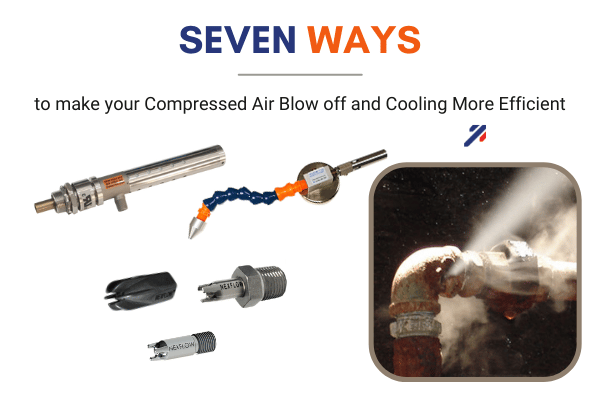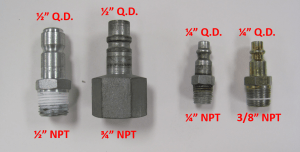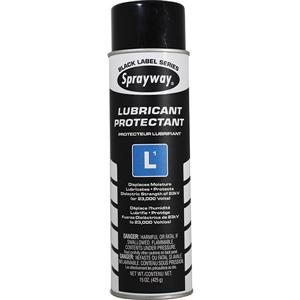Seven Ways to make Compressed Air Blow off

Seven Ways to make your Compressed Air Blow off and Cooling More Efficient
The majority of compressed air is used for blow off and cooling despite the push for alternate technologies like blowers simply because it is still the most efficient to use in a given application, either because of inadequate pressure from blowers, space problems or high capital and maintenance costs.
This is the reality and which is why compressed air use continues to grow.
So how can you make your compressed air use more efficient for blow off and cooling?
- Look at the compressor room – do you need to address the air supply system efficiency? Can you reduce air compressor unloaded times? A great deal of developments in air compressor technology itself can improve overall supply efficiency which in turn increases end use efficiency. Is it the correct size and type for your factory use? Setting the maximum compressed air pressure to a lower level without harming downstream pressure requirements also reduces costs. Every 10 PSIG pressure reduction saves approximately 5% in energy savings.
- Fix leaks- but not just pipe leaks, leaks at worn connectors which should be replaced, stuck auto drains on filters, even unsealed connections to air nozzles, air tools and other compressed air operated equipment. Because leaks also lowers downstream and end use available pressure, just fixing any leaks can help reduce the maximum pressure settings at the air compressors.
- Check pressure losses – while your factory main compressed air piping maybe adequately sized to minimize pressure loss to the point of use, all too often the connection from the main line to the point of use utilizes piping or hose that is simply too small causing excess pressure loss. This is also compounded with fittings that are too small for the air requirement aggravating pressure loss. It is too common to measure pressure at the main line of 100 PSIG and only three feet away have losses up to 30% simply because the line size from the main to the application was too small. Always check the air requirement (AND pressure requirement of the air nozzle, air knife, vortex tube, panel cooler or any other end use product and be sure that the connection line is of adequate size.
- Proper filtration and dryness – when dealing with compressed air blow off and cooling, devices like engineered air nozzles and vortex tubes require clean and dry compressed air. Any dirt buildup over time and excessive moisture negatively affects performance and can even clog the products. Always use point of use filtration to remove any excess moisture and particulate. Inadequate filtration can not only effect the device, it can also impact the quality of the product where any blow off is used.
- Consider on-off control – a huge advantage of compressed air is that it can be stored and used on demand. When not used, it remains stored and energy is not consumed. Utilizing sensors and solenoid valves or a system such as the Nex Flow® PLCFC can take advantage of this storage ability which can yield tremendous energy savings. Many production lines do not need to have the blow off and cooling constantly on.
- Consider New Pulsing Technology – pulsing of compressed air not new and solenoid valves have been used for years to do this. The problem with solenoid valves is however the high wear and tear and therefore the cost to maintain them typically offsetting any energy savings. It is also not certain how much energy is saved as other factors come into play when pulsing occurs. However, pulsing provides scrubbing action to help clean surfaces and a “push” to move or loosen a target where necessary. New process valves have, and still are being developed for pulsing to overcome these maintenance costs and offer potential for improved cleaning with engineered nozzles and for energy saving when properly applied. has done some projects with pulsing so has experience needed when using new pulse technology and offers consulting services for this as well as other applications.
- Stay informed on new technologies for blow off and cooling but beware of false claims – Nex Flow® and a few other companies do research and development to improve products for blow off, cooling and conveying. Many others just copy, (usually not very well) other’s work and sometimes even claim it as their own. To stay focused, Nex Flow® provides compressed air blow off, cooling and conveying products and stays away from things like spray nozzles. Rather than being a supplier of all things, we specialize and share deep knowledge and experience in what we actually know. This is evidenced by our history of success, continued growth and our unique patents of which there are more to come with ongoing R & D and innovation. Be very careful of product claims that make no sense of product performance, some which even defy the laws of physics. Make sure companies that offer blow off and cooling technology can even afford to get proper approvals where necessary such as for control Panel Cooling to be assured they will stay around to service you (and that the product is even legal!). Reliability, timely response, and quality product and service is always important.







